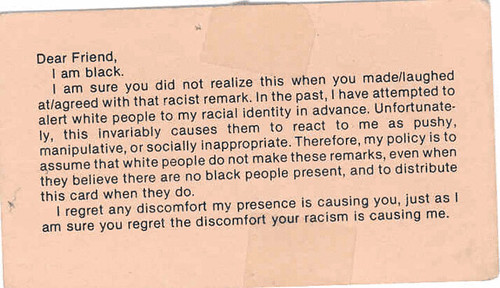
Adrian Piper
Dear Friend,
I am black.
I am sure you did not realize this when you made/laughed at/agreed with that racist remark. In the past, I have attempted to alert white people to my racial identity in advance. Unfortunately, this invariably causes them to react to me as pushy, manipulative, or socially inappropriate. Therefore, my policy is to assume that white people do not make these remarks, even when they believe there are no black people present, and to distribute this card when they do.
— The text of Dr. Piper’s “My Calling Card #1,” a conceptual piece that she performed intermittently, between 1986 and 1990. She would hand out cards to individuals who made a derogatory comment about Black people (see bottom of this page).
***
When I first read about Dr. Adrian Piper’s calling cards, I was thrilled by the wonderful audacity of the piece, both as textual artifact and as performance. It was around this same time (the mid-1990s) that I first encountered the drawings of her “Vanilla Nightmares” series (see below). Once again, the audacity of her work was exhilarating. So too was its incisive critique of so many of the racialized dynamics of the fashion industry, of miscegenation fears, and the literal fear of being consumed by the dark (Black) other.
Piper’s work in more traditional media (paint, collage, pencil, charcoal) is challenging and transgressive, drawing attention to the politics of race in an art world in which women artists of all ethnicities and Black artists of all genders are dramatically underrepresented. If those avenues for exhibiting traditional media tend to marginalize Black art and artists, then one could say that within the world of conceptual art Black artists are virtually non-existent; and the issues that such artists tend to take up in their work go largely unaddressed.
The Adrian Piper Research Archive sums up her role as a racial pioneer in the visual arts with this simple statement: “Adrian introduced issues of race and gender into the vocabulary of Conceptual art and explicit political content into Minimalism.”
Adrian Piper’s role as a pioneer is not limited to the visual arts. In 1987, while teaching at Georgetown University, she became the first African American woman in U.S. history to be tenured in the field of philosophy. During her years at Wellesley College, she would become the first African American woman in the U.S. to ever to be come a tenured full professor of philosophy.
Piper began her academic career by earning an associate’s degree in fine art from New York’s School of Visual Arts. She went on to earn a B.A. in philosophy from City College of New York, and an M.A. and Ph.D. in philosophy from Harvard University. Her interest in German philosophy also took her to the University of Heidelberg in West Germany, where she spent a year studying and translating some of the work of Emmanuel Kant.
Dr. Piper has taught philosophy at a number colleges and universities, including the University of Michigan, Stanford University, Georgetown University, University of California – San Diego, Wellesley College, the Royal Danish Academy of Art, and Ruhr Universität Bochum.
Piper describes the relationship between her two passions in the following passage from “On Becoming a Warrior,” her 2001 essay on the difficulty of managing dual careers in a academic establishment that is structured to accomodate only one area of specialization per faculty member:
For most of my adult life I have worked two full-time jobs, because
choosing between them is not an option for me. In my day job I am a philosophy
professor, and I moonlight as an artist. The two fields are very different.
Academic philosophers teach, do research, serve on committees, and give talks.
Artists who teach do all this, and also produce, document, market, exhibit, and
sell their work. But the two jobs are alike in that the more success you have in
either, the harder it becomes to manage the workload without assistance.
Piper’s teaching and scholarship in philosophy and her production and exhibition in the visual arts coexist alongside her third field of study and practice, hatha yoga. She began studying yoga in 1965, and began studying with Swami Satchidananda in 1966. In 1971 she became a svanistha. In 1985 she became a brahmacharin, a devoted student of yoga whose practice is focused on relinquishing an attachment to external factors and relationships as a source of contentment, and which includes the adoption of a celibate lifestyle. Dr. Piper has published several pieces on the yoga and its relationship to western philosophy. For links to and citations for these publications, click THIS LINK.
For a great online resource on Adrian Piper’s life and work, visit the Adrian Piper Research Archives website.

Adrian Piper. Vanilla Nightmares #8. 1986.

Adrian Piper. My Calling Card #1.
Posted by Ajuan Mance












